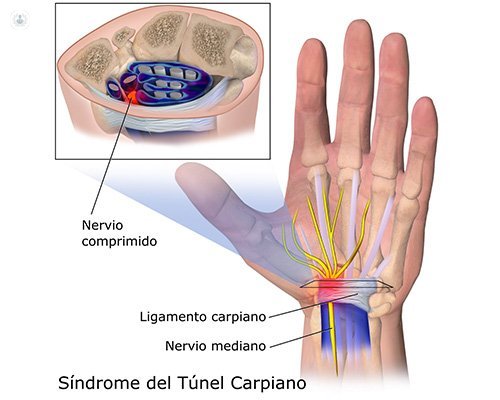Carpal Tunnel Syndrome, can be prevented?
Written by:The Carpal tunnel syndrome is compression of the median nerve as it passes through the carpal tunnel (sulcus carpi), frequent pathology first described by Sir James Paget in 1830. This tunnel is formed by the dorsal side walls and the concavity of the carpal bones and anterior wall, by retinaculoum flexorum. Thus inextensible tunnel walls through which pass the median nerve and flexor tendons 9 is formed fingers.
Causes of Carpal Tunnel Syndrome
The Carpal Tunnel Syndrome is caused by an increase in volume of the contents within the carpal tunnel, which is inextensible. The origin is multiple and may be due to infections, synovitis and vascular hormonal changes, being more frequent in patients with renal failure on dialysis, women in gestation period, sequelae of fractures of distal radius, diabetes and occasionally by microtrauma repeated.

Symptoms of Carpal Tunnel Syndrome
Symptoms and signs presented Tunnel Syndrome of Carpo are paresthesias (in the initial phase), probably due to ischemia or nerve compression, with corky the first 3 fingers, waking at dawn, so the patient has to move your hands, rub them or shake them , until you feel relief. The frequency with which this occurs increases as compression progresses. In advanced cases, paralysis can occur thumb musculature to compress the motor branch of the abductor.
The pain is preferably located at the level of the palm side of the hand, although it can radiate on the territory of the first, second, third and half of the fourth finger. Similarly, there disorders with decreased sensitivity in the same territory of the median nerve distal, first three fingers and the fourth half. There is also impaired discriminative sensitivity for recognizing two contact points on the finger, and in advanced cases atrophy observed in the area proximal thumb at the level of the palm.
Diagnosis of Carpal Tunnel Syndrome
The clinical diagnosis of Carpal Tunnel Syndrome is simple: pain and numbness in the separation of thumb wrist extension, or the test of wrist flexion Phalen; pressure also can cause pain nerve (Tinel test). It can be secured with pneumatic tourniquet test, applying the tension arm apparatus that triggers the symptoms described.
Still, the safest diagnostic means is Electroneurography.
Treatment of Carpal Tunnel Syndrome
Initially it can be treated with the use of night splints, local infiltrations with anti - inflammatory (corticoid type or conditioned serum (Orthokine®)) and ozone therapy.
In case of no response, treatment is surgical, releasing the previous retináculo. It can be performed by classical open surgery, endoscopic surgery with minimal incision and ultrasound-guided surgery, with the latter two less aggressive procedures.
You can prevent Carpal Tunnel Syndrome?
From the point of view of prevention, its appearance is not predictable; It should be treated with early symptoms using splints and anti - inflammatory, and preventing the most common causes described above.



